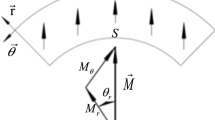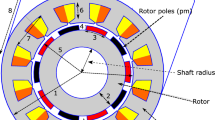Abstract
On the basis of the skewed pole model, this study uses the elite opposition-based golden-sine whale optimization algorithm to carry out the multi-objective optimization design of the frameless external rotor permanent magnet synchronous motor of the robot arm and achieve high torque density and low torque ripple. First, the key parameters affecting the torque ripple and torque density of the motor are analyzed. Second, the angle of the oblique pole is studied to reduce torque ripple. On the basis of the oblique pole model of the motor, the sample library is established according to the key parameters, the K-nearest neighbor algorithm is introduced for regression fitting, and the high-precision and fast calculation model of the motor is established. Third, the elite opposition-based golden-sine whale optimization algorithm (EGWOA) is introduced to optimize the key parameters of the fitting model with the objective of reducing torque ripple and increasing torque density, and the non dominated sorting and crowding degree calculation methods are used to improve it. Finally, a prototype is made to prove the effectiveness of the optimized design.
Similar content being viewed by others
References
M. Zhou, X. Zhang, W. Zhao, J. Ji and J. Hu, Influence of magnet shape on the cogging torque of a surface-mounted permanent magnet motor, Chinese Journal of Electrical Engineering, 5(4) (2019) 40–50, doi: https://doi.org/10.23919/CJEE.2019.000026.
Y. Zhou, H. Li, G. Meng, S. Zhou and Q. Cao, Analytical calculation of magnetic field and cogging torque in surface-mounted permanent-magnet machines accounting for any eccentric rotor shape, IEEE Transactions on Industrial Electronics, 62(6) (2015) 3438–3447, doi: https://doi.org/10.1109/TIE.2014.2369458.
C. Liu, Y. Xu, J. Zou, G. Yu and L. Zhuo, Permanent magnet shape optimization method for PMSM air gap flux density harmonics reduction, CES Transactions on Electrical Machines and Systems, 5(4) (2021) 284–290, doi: https://doi.org/10.30941/CESTEMS.2021.00033.
K. Ahsanullah, R. Dutta and M. F. Rahman, Analysis of low-speed IPMMs with distributed and fractional slot concentrated windings for wind energy applications, IEEE Transactions on Magnetics, 53(11) (2017) 3101710, doi: https://doi.org/10.1109/TMAG.2017.2726117.
X. Fan, B. Zhang, R. Qu, D. Li, J. Li and Y. Huo, Comparative thermal analysis of IPMSMs with integral-slot distributed-winding (ISDW) and fractional-slot concentrated-winding (FSCW) for electric vehicle application, IEEE Transactions on Industry Applications, 55(4) (2019) 3577–3588, doi: https://doi.org/10.1109/TIA.2019.2903187.
X. Wan, S. Yang, Y. Li, Y. Shi and J. Lou, Minimization of cogging torque for V-Type IPMSM by the asymmetric auxiliary slots on the rotor, IEEE Access, 10 (2022) 89428–89436, doi: https://doi.org/10.1109/ACCESS.2022.3201246.
E. Carraro, N. Bianchi, S. Zhang and M. Koch, Design and performance comparison of fractional slot concentrated winding spoke type synchronous motors with different slot-pole combinations, IEEE Transactions on Industry Applications, 54(3) (2018) 2276–2284, doi: https://doi.org/10.1109/TIA.2018.2807382.
K. Liu, M. Yin, W. Hua, Z. Ma, M. Lin and Y. Kong, Design and analysis of halbach ironless flywheel BLDC motor/generators, IEEE Transactions on Magnetics, 54(11) (2018) 8109305, doi: https://doi.org/10.1109/TMAG.2018.2833958.
M.-M. Koo, J.-Y. Choi, H.-J. Shin and J.-M. Kim, No-load analysis of PMLSM with halbach array and PM overhang based on three-dimensional analytical method, IEEE Transactions on Applied Superconductivity, 26(4) (2016) 0604905, doi: https://doi.org/10.1109/TASC.2016.2544940.
P. Jin, Y. Yuan, Q. Xu, S. Fang, H. Lin and S. L. Ho, Analysis of axial-flux halbach permanent-magnet machine, IEEE Transactions on Magnetics, 51(11) (2015) 8207404, doi: https://doi.org/10.1109/TMAG.2015.2449352.
M. Onsal, Y. Demir and M. Aydin, A new nine-phase permanent magnet synchronous motor with consequent pole rotor for high-power traction applications, IEEE Transactions on Magnetics, 53(11) (2017) 8700606, doi: https://doi.org/10.1109/TMAG.2017.2709788.
C. Wang, Z. Zhang, Y. Liu, W. Geng and H. Gao, Effect of slot-pole combination on the electromagnetic performance of ironless stator afpm machine with concentrated windings, IEEE Transactions on Energy Conversion, 35(2) (2020) 1098–1109, doi: https://doi.org/10.1109/TEC.2020.2971533.
J. Rao, Y. Gao, D. Li and R. Qu, Performance analysis of interior permanent magnet motor using overlapping windings with fractional ratio of slot to pole pair, IEEE Transactions on Applied Superconductivity, 26(7) (2016) 0610005, doi: https://doi.org/10.1109/TASC.2016.2599206.
D. Wang, C. Peng, J. Li and C. Wang, Comparison and experimental verification of different approaches to suppress torque ripple and vibrations of interior permanent magnet synchronous motor for EV, IEEE Transactions on Industrial Electronics, 70(3) (2023) 2209–2220, doi: https://doi.org/10.1109/TIE.2022.3156034.
L. Wu, R. Qu, D. Li and Y. Gao, Influence of pole ratio and winding pole numbers on performance and optimal design parameters of surface permanent-magnet vernier machines, IEEE Transactions on Industry Applications, 51(5) (2015) 3707–3715, doi: https://doi.org/10.1109/TIA.2015.2426148.
O. Gundogmus et al., Acoustic noise mitigation in high pole count switched reluctance machines utilizing skewing method on stator and rotor poles, IEEE Transactions on Industrial Electronics, 69(6) (2022) 5581–5593, doi: https://doi.org/10.1109/TIE.2021.3095808.
Z. Shi et al., Torque analysis and dynamic performance improvement of a PMSM for EVs by skew angle optimization, IEEE Transactions on Applied Superconductivity, 29(2) (2019) 0600305, doi: https://doi.org/10.1109/TASC.2018.2882419.
Y. Ueda, H. Takahashi, A. Ogawa, T. Akiba and M. Yoshida, Cogging-torque reduction of transverse-flux motor by skewing stator poles, IEEE Transactions on Magnetics, 52(7) (2016) 8203504, doi: https://doi.org/10.1109/TMAG.2016.2523551.
Y.-R. Kang, J.-C. Son and D.-K. Lim, Optimal design of IPMSM for fuel cell electric vehicles using autotuning elliptical niching genetic algorithm, IEEE Access, 8 (2020) 117405–117412, doi: https://doi.org/10.1109/ACCESS.2020.3004722.
A. G. de Castro, P. R. U. Guazzelli, C. M. R. de Oliveira, W. C. de A. Pereira, G. T. de Paula and J. R. B. de A. Monteiro, Optimized current waveform for torque ripple mitigation and MTPA operation of PMSM with back EMF harmonics based on genetic algorithm and artificial neural network, IEEE Latin America Transactions, 18(9) (2020) 1646–1655, doi: https://doi.org/10.1109/TLA.2020.9381808.
J. Gao, L. Dai and W. Zhang, Improved genetic optimization algorithm with subdomain model for multi-objective optimal design of SPMSM, CES Transactions on Electrical Machines and Systems, 2(1) (2018) 160–165, doi: https://doi.org/10.23919/TEMS.2018.8326463.
T. Ishikawa, K. Nakayama, N. Kurita and F. P. Dawson, Optimization of rotor topology in PM synchronous motors by genetic algorithm considering cluster of materials and cleaning procedure, IEEE Transactions on Magnetics, 50(2) (2014) 637–640, doi: https://doi.org/10.1109/TMAG.2013.2282365.
Z. Chen, W. Li, X. Shu, J. Shen, Y. Zhang and S. Shen, Operation efficiency optimization for permanent magnet synchronous motor based on improved particle swarm optimization, IEEE Access, 9 (2021) 777–788, doi: https://doi.org/10.1109/ACCESS.2020.3047257.
F.-J. Lin, L.-T. Teng and H. Chu, A robust recurrent wavelet neural network controller with improved particle swarm optimization for linear synchronous motor drive, IEEE Transactions on Power Electronics, 23(6) (2008) 3067–3078, doi: https://doi.org/10.1109/TPEL.2008.2002081.
Z. Niu, Z. Sun and C. Chen, Optimization of the rotor structure of a hollow traveling wave ultrasonic motor based on response surface methodology and self-adaptive genetic algorithm, Proceedings of the CSEE, 34(30) (2014) 5378–5385 (in Chinese).
Z. Xiao and S. Liu, Elite opposition-based golden-sine whale optimization algorithm and its engineering optimization research, Acta Electronica Sinica, 47(10) (2019) 2177–2186 (in Chinese).
Acknowledgments
This work was supported by Natural Science Foundation of Anhui Province (2108085ME179), National Natural Science Foundation of China (51607002), Key project of National Natural Science funds (51637001).
Author information
Authors and Affiliations
Corresponding author
Additional information
Fang Xie was born in 1977. She received her Ph.D. degree in Circuits and Systems from Anhui University, Hefei, China, in 2015. She is presently working as a Professor in the School of Electrical Engineering and Automation, Anhui University. Her current research interests include motor control and power electronic technology.
Houying Wang was born in July 1998. He is currently working toward his master’s degree in electrical engineering with the School of Electrical Engineering and Automation, Anhui University, Hefei, China. His research interests include motor control and Design of Permanent Magnet Synchronous Motor.
Shilin Ni was born in February 1999. Currently, he is pursuing a Master’s degree in Electronic Information at the School of Electrical Engineering and Automation, Anhui University, Hefei, China. His research interests include motor control and motor control system design.
Jinhu Xu obtained a Bachelor’s degree in Electrical Engineering and Automation from Anhui Jianzhu University in Hefei, China in 2021 and is currently pursuing a Master’s degree in Motor Control. His current research interests include the control of permanent magnet synchronous motor drive.
Ziang Ang was born in 2001. He is presently working towards his M.S. degree in Electrical Engineering in the School of Electrical Engineering and Automation, Anhui University, Hefei, China. His current research focuses on the design of permanent magnet synchronous motors.
Rights and permissions
About this article
Cite this article
Xie, F., Wang, H., Ni, S. et al. Multi-objective optimization design of external rotor permanent magnet synchronous motor for robot arm. J Mech Sci Technol 38, 803–814 (2024). https://doi.org/10.1007/s12206-024-0127-8
Received:
Revised:
Accepted:
Published:
Issue Date:
DOI: https://doi.org/10.1007/s12206-024-0127-8




